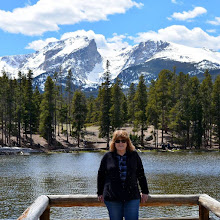We had friends visiting Colorado from New York for a month this summer. Their first grandchild was born to their son and daughter-in-law, who live in a suburb in the Denver area, and they were excited to spend time with the new parents and grandbaby. While they stayed nearby, we had a lot of fun showing them some of our favorite Colorado sights, and also some sights that were new to us. One of those new sights for us, that I had heard about and wanted to see, was the John Denver Sanctuary in Aspen, Colorado. (This photo, and all photos in this post, can be enlarged for easier viewing by clicking in them.)
Our drive west to Aspen took a little over 3 hours. We took the beautifully scenic Independence Pass to cross the Continental Divide. (See a prior post--click here--we made over the pass in June) When we entered Aspen we could see the ski runs in the mountains. Aspen attracts people from around the world for it's year round recreation and renown festivals, and it has some of the highest real estate property in the nation.
Aspen is also known for its high end restaurants, boutiques and landmarked buildings dating back from its Gold Rush days. We had a nice time walking around the town to look at the sights and to have lunch.
I always wanted to see the John Denver Sanctuary, so after lunch we headed towards the eastern end of downtown Apen near Rio Grande Park, where it is located along the Roaring Fork River.
John Denver, whose real name was Henry John Deutschendorf, Jr., was one of the most famous best selling acoustic singer/songwriter of the 1970's in the United States. He, and his first wife, Annie, moved to Aspen in 1971, just as his recording career was beginning to be a success. Although they divorced in 1982, they both continued to live in Aspen. Sadly, at age 53, John Denver was killed when the small experimental plane he was flying crashed on October 12, 1997 near Pacific Grove, California.
Walking into the sanctuary area we were greeted by this stone, surrounded by flowers, which stated:
John Denver Sanctuary
Earth, Water, Mountain, Sky, Pause, Reflect, Enjoy
The sanctuary path was lined with both boulders and flowers and accented by the sound of water and ...
...small gentle waterfalls.
It was serene and beautiful.
We approached steps that had a boulder on top that announced "John's Song Garden."
There, arranged in a circle formation, were large and small boulders that were inscribed with song lyrics that John Denver wrote.....
...and included this tribute stone to his life, which stated: "I am a song, I live to be sung, I sing with all my heart.'
One of John Denver's most popular songs was "Rocky Mountain High."
Please click on to enlarge.
Other boulders contained other song lyrics. I think bedsides Rocky Mountain High, "Annie's Song" is one of my favorites, as well as "Take Me Home, Country Roads." Do you have a favorite John Denver song?
I'm sure I missed a few boulders with lyrics, as we spent quite a bit of time reading the ones we saw, and enjoying the tranquility of the area. All too soon it was time to head back to the garage where we parked our car, as we had a long drive back.
I was glad to have spent part of the time I had in Aspen at the John Denver Sanctuary. Every year in October, there is a remembrance celebration held here and in other areas of Colorado, for John Denver. This will be the 20th anniversary of his passing and with the area's surrounding aspen trees turning autumnal colors it must be very beautiful to visit at that time.
Driving back east on Interstate 70, with mountains on the horizon--a sight that still fills me with awe!
It is hard to believe that summer will be coming to a close soon and my grandchildren will be heading back to school. It will be a busy time for my family and I am anticipating that I may take a little blog break, but I will be back soon!
I'm linking this post to the following blog events:
Amaze Me Monday, All Seasons, Blue Monday, Through My Lens Monday, Mosaic Monday, Inspiration Monday, Blogging Grandmothers,
You Are the Star Blog Hop, Good Random Fun, Nature Notes, Grand Social, Photo Tunes, Tuesday Talk, Tuesday Treasures, Our World Tuesday, Ruby Tuesday,Wordless Wednesday, Oh My Heartsie Girl's Wonderful Wednesday, Outdoor Wednesday, Wonderful Wednesday, Share Your Cup Thursday,Little Things Thursday, No Rules Blog Linky, Travel Photo Thursday, Thankful Thursday, Thursday Favorite Things, Friday Photo Journal, Skywatch Friday, Sweet Inspiration, Weekend Travel Inspiration, Pink Saturday, Over the Moon
Thank you to all the blog hosts!

























































